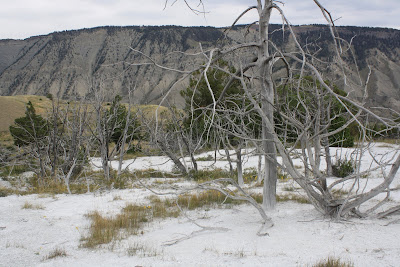Bridget:
You might think that after visiting so many national parks, they would all start to run together. Simply put, Yellowstone breaks all preconceived notions of what a national park should be. If I had to describe it in one word? Variety. Variety in landscape, variety in wildlife, variety in geology. This park has the world’s largest concentration of geysers and, of course, the most popular one, Old Faithful. This geyser spews out water at a temp of 204 degrees F every 60-90 minutes. I have heard so much about Old Faithful that I just had to see it for myself. We entered the park very early on a Sunday morning and of course made our first stop at Old Faithful. It is pretty amazing that you don’t even have to hike to see it. It is such a popular attraction that the size of the parking lot is similar to that of a shopping mall, and the geyser area is surrounded by benches three rows deep. When we arrived, we checked the visitor center for the next eruption time which was 9:07 a.m. It’s amazing to me that they can pinpoint the eruption times so accurately when the eruptions still vary in intervals and length. Here is a video clip of what we saw:
Besides the large concentration of geysers, fumaroles, mudpots, and hot springs, the park also has one of the largest and most diverse wildlife populations. At any point while driving through the 2.2 million-acre park, you might get a glimpse (or an up-close encounter) with any of the following: Elk, moose, bison (buffalo), black bears, grizzly bears, wolves, bighorn sheep, pronghorns, coyotes, marmots, squirrels, and a variety of birds. We first saw a few elk hanging out by the road early in the morning.
Then not too long after that we saw the first buffalo strolling along the side of the road by him/herself. Wow…they are huge. At first, I was so taken away by their size and seemingly tame nature (which in fact they are very dangerous and unpredictable), but then we drove by Hayden Valley, a hotspot for buffalo herds. Not only did we get some good views of these incredible animals, but a few of them decided to give us an extremely up-close and personal encounter, all the while holding up traffic for very long periods of time.



After getting past “Buffalo Rush Hour” we headed up to Canyon Village area, where the Upper Falls and Lower Falls are located along the Yellowstone River and Canyon. We first hiked along the South Rim trail to Artist Point where you can look back up the colorful Yellowstone Canyon and see Lower Falls roaring over the cliff:

Then we hiked back along the rim and down the Uncle Tom’s Trail which is a series of very steep stairs that lead down to an almost-bottom viewing point:
 After huffing and puffing our way back up the never-ending stairs, we walked back up to the Upper Falls to get picture of that too:
After huffing and puffing our way back up the never-ending stairs, we walked back up to the Upper Falls to get picture of that too:
Back in the car and a bit further north, we detoured to see Tower Falls. Craig said he remembered hiking this trail with his family down to the very bottom of the falls. Unfortunately, the trail is now closed off at the bottom, so your view of the falls is limited to an upper viewing area:

Nevertheless, it is still gorgeous. Onward to the north of the park. The last and final point of interest we had to see was Mammoth Hot Springs. After reading some of the information boards, we learned that these types of hot springs can go through periods of dormancy, which most of the Mammoth Hot Springs seems to be in. There was one side, however, that still looked alive and vibrant with colors:

The rest of the area has turned a ghostly white from the dried limestone, and the calcium has clogged the root systems of the trees, transforming them into gnarled formations that make the terrain appear like something out of a horror flick:


On our way out of the Mammoth Hot Spring area, we said our goodbyes to the several dozen elk chilling on the greens:




No comments:
Post a Comment